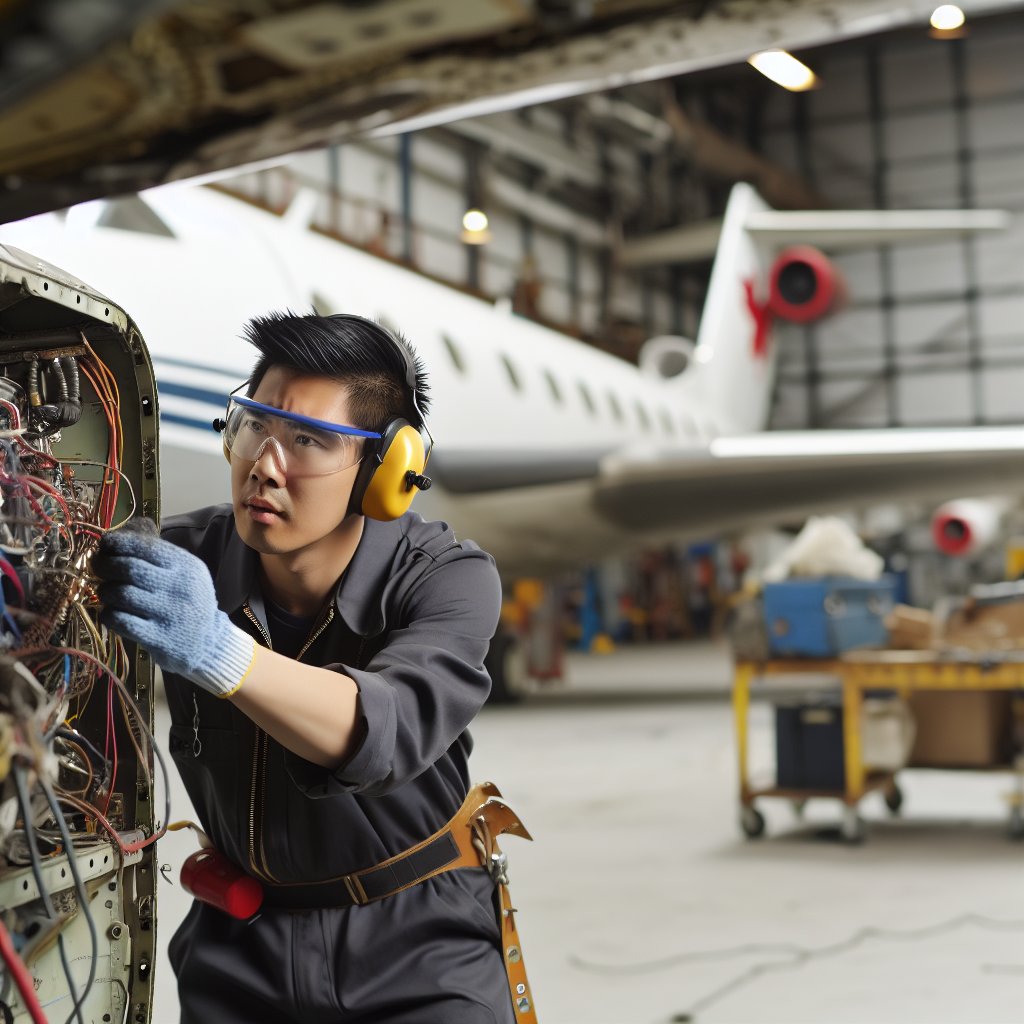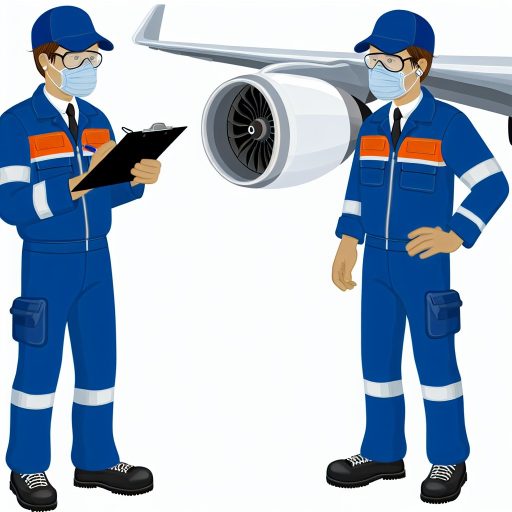Introduction to Aviation Maintenance Technology
Aviation maintenance technology is crucial for aircraft safety and performance.
Aviation maintenance technicians ensure that all systems work efficiently.
They perform regular inspections and repairs on various aircraft types.
The advancements in technology have transformed the industry significantly.
Importance of Aviation Maintenance
Proper maintenance prevents accidents and enhances passenger safety.
Regular checks help identify potential issues before they escalate.
Moreover, maintenance maintains the aircraft’s operational efficiency.
This efficiency, in turn, reduces operational costs over time.
Role of Technicians in the Industry
Aviation maintenance technicians undergo rigorous training.
They must understand complex systems and components.
Commonly, technicians specialize in specific aircraft or systems.
Ultimately, their expertise ensures compliance with safety regulations.
Tools and Equipment Used by Technicians
Technicians rely on various tools to perform their duties effectively.
Common tools include wrenches, torque tools, and diagnostic equipment.
Additionally, advanced avionics and software tools enhance precision.
Continuous education helps technicians stay updated with new tools.
Essential Hand Tools for Technicians
Basic Hand Tools
Every aviation maintenance technician needs reliable basic hand tools.
These tools ensure accuracy and efficiency during repairs.
Common basic hand tools include wrenches, screwdrivers, and pliers.
Standard wrenches come in various sizes for different applications.
Technicians often use both metric and imperial sizes.
Screwdrivers should have a range of flathead and Phillips options.
Pliers assist with gripping and bending wires and other materials.
Specialized Tools
In addition to basic tools, specialized tools play a critical role.
Technicians often require torque wrenches to ensure proper fastening.
Unlock Your Career Potential
Visualize a clear path to success with our tailored Career Consulting service. Personalized insights in just 1-3 days.
Get StartedCalipers help in measuring components with precision.
Digital multimeters are essential for electrical diagnostics.
Analyzers assist in troubleshooting fuel systems and electronics.
Safety Tools
Safety should always be a priority in aviation maintenance.
Personal protective equipment is vital for safe work practices.
Safety goggles protect against flying debris during repairs.
Ear protection is essential when working near loud machinery.
Steel-toed boots provide foot protection from heavy objects.
Storage Solutions
Proper storage makes tools accessible and organized.
Toolboxes and storage cabinets are essential for every technician.
Some technicians prefer tool belts for easy access during work.
Magnetic trays can help keep small parts from getting lost.
Maintenance of Tools
Regular maintenance extends the life of hand tools.
Clean tools after each use to prevent rust and damage.
Inspect tools regularly for wear and tear.
Store them in a dry place to reduce the risk of corrosion.
Sharpen blades as needed for optimal performance.
Specialized Tools for Aircraft Inspection
Overview of Aircraft Inspection Tools
Aircraft inspection tools ensure flight safety and compliance with regulations.
These tools help technicians assess an aircraft’s structural integrity.
Using appropriate inspection tools increases efficiency and accuracy.
Therefore, choosing the right tools is crucial for aviation maintenance technicians.
Common Inspection Tools Used
Several tools are essential for effective aircraft inspection.
- Torque wrenches secure components to specified limits.
- Digital calipers measure precise dimensions.
- Ultrasonic thickness gauges assess material integrity.
- Borescopes allow for internal inspections in tight spaces.
- Magnetic particle inspection kits detect surface cracks.
Each tool serves a unique purpose in the inspection process.
Importance of Compliance and Standards
Inspection tools must comply with industry standards and regulations.
This helps ensure the safe operation of aircraft.
Regulatory bodies set guidelines for the use and calibration of tools.
Consequently, technicians must stay informed about these regulations.
Best Practices for Tool Maintenance
Maintaining inspection tools is vital for their longevity and accuracy.
Regular cleaning prevents dirt and debris accumulation.
Calibration should be performed according to manufacturer specifications.
Furthermore, technicians should inspect tools regularly for wear and damage.
Emerging Technologies in Inspection Tools
New technologies enhance the capabilities of aircraft inspection tools.
For example, drones are increasingly used for external inspections.
Additionally, AI systems assist with data analysis during inspections.
These advancements lead to more efficient and thorough inspections.
Learn More: Freight Forwarder Career Pathways And Opportunities
Maintenance Software and Digital Tools
Importance of Maintenance Software
Maintenance software streamlines aviation maintenance operations.
It enhances communication among technicians and management.
Moreover, it allows for real-time tracking of maintenance tasks.
This software reduces paperwork and increases efficiency.
Popular Maintenance Software Options
Several maintenance software solutions are popular in the aviation industry.
- JetEngine Pro offers comprehensive engine maintenance tracking.
- AirMaster simplifies airframe maintenance management.
- TechLog Central integrates maintenance tasks with real-time data.
- MaintainX allows for easy workflow management and task assignments.
The Role of Digital Tools
Digital tools complement maintenance software effectively.
They provide technicians with access to crucial data on-the-go.
Examples include mobile apps and digital checklists.
These tools improve accuracy and reduce errors.
Benefits of Using Digital Tools
Digital tools foster better organization within maintenance teams.
They enable quick reporting and updating of maintenance records.
Additionally, they enhance compliance with safety regulations.
These tools lead to increased productivity.
Integrating Software and Digital Tools
Integrating maintenance software and digital tools creates seamless operations.
This integration enhances the flow of information across departments.
Consequently, technicians can focus on high-priority tasks.
Moreover, it ensures that essential data is always available.
Uncover the Details: How to Improve Driver Safety as a Fleet Manager
Safety Equipment Required in Aviation Maintenance
Personal Protective Equipment
Personal protective equipment is essential in aviation maintenance.
It includes helmets, goggles, and gloves.
Technicians must wear safety shoes to protect their feet.
High-visibility vests help ensure that workers are seen in busy environments.
Moreover, ear protection is necessary when working near loud machinery.
Fall Protection Systems
Working at heights requires effective fall protection systems.
Body harnesses are critical when technicians work on elevated surfaces.
Guardrails and safety nets enhance safety by preventing falls.
Additionally, proper training on using such systems is imperative.
Fire Safety Equipment
Fire safety is a top priority in aviation maintenance.
Fire extinguishers should be easily accessible in work areas.
Also, technicians must know how to use fire suppression tools.
Regular fire drills can prepare staff for an emergency.
Respiratory Protection
Respiratory protection is vital when dealing with hazardous materials.
Respirators protect against harmful fumes and particulates.
Workers must evaluate air quality frequently to ensure safety.
Training on the proper use of respiratory devices is crucial.
First Aid Kits
Every aviation maintenance facility must have first aid kits available.
These kits should be fully stocked with essential medical supplies.
Training staff on first aid procedures can save lives.
Regularly checking and restocking these kits is necessary.
See Related Content: Managing Large Vehicle Fleets Efficiently in Canada

Calibration and Measurement Tools for Precise Maintenance
Importance of Calibration Tools
Calibration tools ensure precision in aviation maintenance tasks.
They help technicians validate and adjust instruments effectively.
This accuracy reduces the risk of operational failures.
Furthermore, it enhances overall flight safety.
Essential Calibration Instruments
- Digital Multimeters
- Torque Wrenches
- Calipers
- Tachometers
Digital multimeters measure voltage, current, and resistance accurately.
They are invaluable for troubleshooting electrical systems.
Torque wrenches ensure that bolts are tightened to specified values.
Using them prevents excessive wear and potential malfunctions.
Calipers assist in measuring dimensions with high precision.
They are crucial for inspecting components and assemblies.
Tachometers measure rotational speed, vital for engine evaluations.
Regular checks can prevent unexpected mechanical issues.
Measurement Tools for Maintenance Tasks
- Micrometers
- Pressure Gauges
- Humidity Meters
- Temperature Probes
Micrometers provide accurate thickness measurements for components.
Pressure gauges assess system pressures in pneumatic and hydraulic systems.
This ensures operational integrity and safety standards.
Humidity meters help in maintaining optimal environmental conditions.
They are essential for preventing corrosion and other damages.
Temperature probes gauge the heat levels in critical areas.
Monitoring temperatures protects sensitive systems from overheating.
Maintenance of Calibration and Measurement Tools
Proper maintenance extends the life of calibration instruments.
Regular cleaning and calibration verification prevent inaccuracies.
Technicians should follow manufacturer guidelines for best practices.
Storing tools in controlled environments minimizes wear and tear.
Additionally, maintaining a calibration schedule ensures reliability.
Find Out More: How To Excel In Freight Forwarding Interviews
Common Power Tools Used in Aviation Maintenance
Wrenches
Wrenches are essential for aviation maintenance tasks.
Mechanics frequently use socket and open-end wrenches.
Socket wrenches provide quick and easy access to tight spaces.
Open-end wrenches offer versatility for various fasteners.
Both types help avoid damage to sensitive components.
Screwdrivers
Screwdrivers are vital for assembling and disassembling parts.
Professionals often utilize both flathead and Phillips head varieties.
Magnetic screwdrivers help hold screws in place during work.
Additionally, rotating handle screwdrivers offer better torque application.
Dremels and Rotary Tools
Dremels serve multiple functions in aviation maintenance.
Technicians use them for grinding, cutting, and polishing tasks.
Flexible shafts enhance accessibility in hard-to-reach areas.
Furthermore, many attachments cater to specific maintenance needs.
Impact Wrenches
Impact wrenches are crucial for fastening and loosening bolts efficiently.
They provide high torque output with minimal effort.
This tool is particularly effective on stubborn or rusted fasteners.
Battery-powered models offer portability and ease of use.
Drills
Drills are among the most used power tools in aviation maintenance.
Both corded and cordless models have become standard equipment.
Variability in drill bits allows for drilling different materials.
Furthermore, adjustable speeds improve precision for delicate tasks.
Tool Organization and Storage Solutions for Technicians
Importance of Organization
Proper organization enhances efficiency for aviation maintenance technicians.
Technicians achieve faster access to tools when items are well-organized.
Additionally, organization minimizes the risk of losing critical equipment.
Types of Storage Solutions
There are various storage solutions available for aviation maintenance tools.
Toolboxes provide portable storage for frequently used items.
Carts allow for mobility and easy access within the workplace.
Wall-mounted pegboards can display tools for immediate visibility.
Choosing the Right Toolbox
Selecting an effective toolbox depends on individual needs and preferences.
Consider size options to accommodate all necessary tools.
Look for materials that ensure durability and protection from wear.
Additionally, choose designs that allow for easy mobility when required.
Utilizing Carts for Better Workflow
Carts enable technicians to transport tools between work areas efficiently.
Using carts can significantly reduce the time spent searching for tools.
Look for carts with multiple shelves for various tool categories.
Implementing Pegboards and Wall Storage
Pegboards enhance workplace organization by utilizing vertical space.
Technicians can categorize tools for easy retrieval and storage.
Labeling sections provides quick identification of tools when needed.
Maintaining an Inventory
An organized inventory system supports overall tool management.
Regularly updating inventory helps technicians track tools effectively.
Software solutions can automate the inventory process for added convenience.
Additionally, an updated list assists in identifying tools that require replacement.
Safety Considerations
Proper storage of tools is essential for maintaining a safe workspace.
Ensure all sharp or hazardous tools are secured properly away from others.
Regularly inspecting storage solutions can prevent unexpected injuries.
Also, consider training on safe handling and storage practices.
Additional Resources
Programs – Ivy Tech Community College
Types and Categories of Flight Disruption: A Guide | Canadian …




